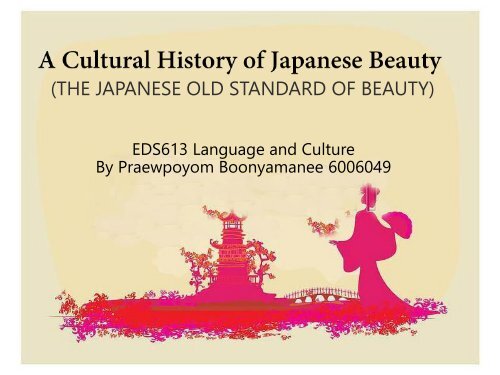Create successful ePaper yourself
Turn your PDF publications into a flip-book with our unique Google optimized e-Paper software.
(THE JAPANESE OLD STANDARD OF BEAUTY)<br />
EDS613 Language and Culture<br />
By Praewpoyom Boonyamanee 6006049
Select one that is close to<br />
home and familiar.<br />
Old woman fashion beauty<br />
come to mind first is ….<br />
unique<br />
make up<br />
Woman and <strong>Beauty</strong> go<br />
together<br />
Why did they cover face like that?<br />
How to did ?
• To study <strong>Cultural</strong> <strong>History</strong> <strong>of</strong> <strong>Japanese</strong> <strong>Beauty</strong><br />
• To understand old <strong>Japanese</strong> standard <strong>of</strong> beauty
There are three mains old <strong>Japanese</strong> standard beauty<br />
1<br />
Oshiroi<br />
2<br />
3<br />
Hikimayu<br />
Ohaguro
Oshiroi<br />
It’s running from 794 - 1185<br />
Women painted their face with a white powder
Oshiroi<br />
It’s running from 794 - 1185
Oshiroi<br />
It’s running from 794 - 1185<br />
Reason to did white painted face:<br />
• look better in the candlelight<br />
• clearly visible
Hikimayu<br />
It’s running from 794 - 1185<br />
Hiki + mayu<br />
=<br />
Hikimayu<br />
pull<br />
+ eyebrows<br />
= Pull eyebrows up<br />
The meaning <strong>of</strong> hikimayu :<br />
Plucking or shaving the eyebrows<br />
and repainting them higher on the<br />
forehead.
Hikimayu<br />
It’s running from 794 - 1185<br />
Original eyebrows
Hikimayu<br />
It’s running from 794 - 1185<br />
Reason to did hikimayu :<br />
• Easy to put on oshiroi<br />
• To prevent political<br />
opponents read emotions
Ohaguro<br />
It’s running from 794 - 1185<br />
歯 (ha) + 黒 (kuro)<br />
=<br />
ohaguro<br />
teeth + black<br />
= Blackened Teeth<br />
The meaning <strong>of</strong> ohaguro :<br />
A practice in which people (usually<br />
women) dye their teeth black. It was also<br />
done by adult aristocrats and nobles<br />
regardless <strong>of</strong> gender on a daily basis.
Ohaguro<br />
Only common among:<br />
It’s running from 794 - 1185<br />
Time pass to<br />
“Muromachi period”<br />
Common among:<br />
Nobles<br />
Samurai &<br />
Provincial warriors<br />
Lower classes
Ohaguro<br />
It’s running from 794 - 1185<br />
Reason to did ohaguro:<br />
• Blackened teeth with white<br />
painted face was complimentary<br />
• A mark <strong>of</strong> sexual maturity<br />
• To hide crooked or yellowed teeth<br />
• To hide the scar from the battle<br />
• Seeing someone's white teeth<br />
was compared with seeing<br />
someone's bones or seeing a<br />
mouthful <strong>of</strong> mealworms<br />
• it prevented tooth decay , in a<br />
similar fashion to modern dental<br />
sealants
A Tang Dynasty Lady (China)<br />
A Hein Lady (Japan)
1. Many Westerners who visited Japan described ohaguro as a<br />
repugnant <strong>Japanese</strong> custom which disfigured <strong>Japanese</strong><br />
women by making the women intentionally unattractive.<br />
“ One day a handsome Captain happened to pass by<br />
by and admired her from a distance. But then she<br />
smiled and he saw her unblackened teeth gleaming<br />
and flashing and was quite disgusted. ‘There was<br />
something wild and barbaric about it.’ ”
2. On February 5, 1870, the government banned ohaguro and<br />
the process gradually became obsolete.<br />
3. After World War II and beginning in the 1950s, Japan was<br />
heavily influenced by American mass media such as principle<br />
magazines and movies, so the understanding <strong>of</strong> makeup<br />
increased.<br />
4. In present days, <strong>Japanese</strong>
1. These three customs reflected the belief that modesty<br />
<strong>of</strong> expression was a virtue and part <strong>of</strong> a woman’s<br />
proper demeanor.<br />
2. Different cultures have varied standards for female<br />
beauty. Some societies prefer women with stretched<br />
lower lips, or facial tattoos, or brass rings around their<br />
elongated necks. They are proud to show <strong>of</strong>f their<br />
culture, so you don't immediately think <strong>of</strong> decay,<br />
judge them be the barbaric when you see the<br />
different cultures from your country.
ありがとうございます<br />
Arigatou gozaimas(u)<br />
Thank you


